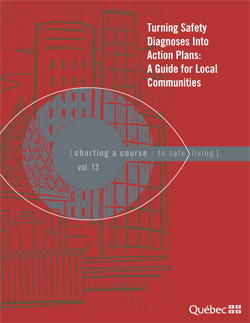Turning Safety Diagnoses Into Action Plans: A guide for Local Communities
In recent years, several tools based on a setting-oriented approach have been developed to support safety promotion and crime prevention initiatives. This approach advocates the use of a structured procedure for planning and implementing prevention measures in life settings. The procedure involves mobilizing the population and intersectoral partners, making safety diagnoses and preparing action plans. The present document, Turning Safety Diagnoses Into Action Plans: A Guide for Local Communities, is one of the tools that follows this setting-oriented approach. It is designed to assist people who are working to develop coherent, integrated action plans that propose feasible, acceptable and effective actions based on safety diagnoses.
It is taken for granted in this tool that 1) local safety promotion and crime prevention initiatives aresupported by a cooperative mechanism, 2) the communities concerned are mobilized around the issues of safety promotion and crime prevention and 3) safety diagnoses have been completed. Therefore, the point of departure for the activities discussed in this guide is a list of safety problems that have been identified in a diagnosis and that, ideally, have been documented and validated with your partners and the target population.
The guide describes the steps involved in turning safety diagnoses into action plans. However, it is important to bear in mind that the procedure outlined here represents an ideal approach and that local realities (issues, sociopolitical context, available resources, etc.) must of course be taken into account when applying it. In short, the goal is to strive toward this ideal, while remaining flexible.
Throughout the discussion of the procedure for turning diagnoses into action plans, the guide suggests appropriate references whose usefulness will vary depending on your needs. It also provides a checklist following the description of each step to assist you with the different activities. This checklist may serve simply as a reminder of the activities to be carried out and the conditions needed for this purpose or it may be used to facilitate reflection on the progress that has been made. Lastly, for easier understanding, the guide uses an evolving example to illustrate the different steps involved in the procedure. This example, which is broken down into a series of sub-examples presented at the end of each section of the guide, describes the activities carried out by a fictitious municipality during each step.
- Turning safety diagnoses into action plans: activity checklist
- Gaining a good grasp of priority problems
- Model action plan
Last update in French: January 7th, 2022.


